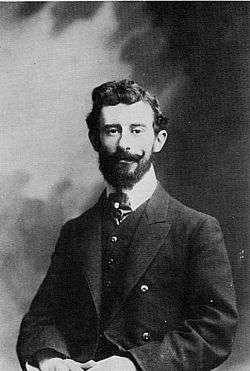Sonatine (Ravel)
Sonatine is a piano work written by Maurice Ravel. Although Ravel wrote in his autobiography that he wrote the sonatina after his piano suite Miroirs, it seems to have been written between 1903 and 1905.[1] He most likely referred to the dates he finished both of the works.
| Sonatine | |
|---|---|
| by Maurice Ravel | |
 The composer in 1907 | |
| Dedication | Ida and Cipa Godebski |
| Performed | 10 March 1906 |
| Movements | three |
| Scoring | piano |
Composition
Ravel wrote the first movement of the Sonatine for a competition sponsored by the Weekly Critical Review magazine after being encouraged by a close friend who was a contributor to that publication. The competition requirement was the composition of the first movement of a piano sonatina no longer than 75 bars,[2] with the prize being 100 francs.
In 1941 the publication Music & Letters printed the article When Ravel Composed to Order by Michel Dimitri Calvocoressi. Calvocoressi discussed how he supposedly encouraged Ravel to write the piece in response to a competition posted in the Paris Weekly Critical Review. Peter Jost of G. Henle Publishers found the original article in the Review published in three March 1903 editions. The original manuscript that Ravel submitted had the text ‘par Verla’ written and struck out, replaced with ‘par Maurice Ravel’. Ravel submitted the piece under a pseudonym and chose an anagram of his name.[3]
The Sonatine was first performed fully in Lyon on March 10, 1906 by Paule de Lestang.[4] Shortly afterwards the piece received a Paris premiere, where it was played by Gabriel Grovlez.[5] The work was dedicated to Ida and Cipa Godebski; he later dedicated his Ma mère l'Oye suite to their children.
Structure
The piece is in three movements:
- Modéré (moderate)
- Mouvement de menuet (Minuet tempo)
- Animé (animated)
The leaping fifth melody of the first movement reappears in variations against different textures in the second and third movements.[6]
The first movement is a well-structured, even straightforward, sonata form (albeit utilizing Ravel’s Impressionistic harmonic colorings). Two themes emerge in the exposition—the first in tonic key of F-sharp minor, and the second in D major and B minor. Owing to its diminutive form, the following minuet exists without a trio. Shifting to the key of the dominant (here spelt as D-flat major), it unfolds as a slow waltz, elegant and restrained but nonetheless building through moments of passion and intensity. Lastly, the toccata finale is the most technically challenging of the Sonatine’s three movements. Inspired in part by the keyboard writing of Couperin and Rameau, the movement shifts restlessly between 3/4 and 5/4 time and abounds in energy, driving the work to a brilliant conclusion. [7]
Keys
Both the first and third movements begin in F♯ minor and end in F♯ major. The middle movement is in D♭ major.
Reception
Reception for Ravel's Sonatine has been mixed but generally favorable. Marcel Marnat wrote that Sonatine captivates us from the very first measure in its depth,[1] adding that in its conciseness and radiance, it is one of Ravel's defining works. In contrast, Arbie Orenstein has written that while Sonatine is pleasant enough, it does not compare to the later Miroirs.[1]
Ravel was known to value the work and performed it frequently. Sonatine is easier than some of his other works, such as Gaspard de la nuit, and Ravel (who was anxious about his skills as a pianist) probably performed it because of this. He did not, however, perform the third movement, as it was technically challenging for him.[8]
Arrangement
Carlos Salzedo transcribed Sonatine for flute, harp and cello (or viola), titling the transcription Sonatine en Trio.
Notes
- Maurice Ravel - Sonatine Archived 2017-09-22 at the Wayback Machine
- Dowling, Richard. (2003) Sonatine by Maurice Ravel
- "Curiosity pays off. The genesis of Maurice Ravel's piano 'Sonatine' | Henle Blog". Henle.de. 2012-03-19. Retrieved 2016-12-30.
- Description by Meredith Gailey. "Sonatine for piano in F sharp minor | Details". AllMusic. Retrieved 2016-12-30.
- "Sonatine - Hyperion Records - CDs, MP3 and Lossless downloads". Hyperion Records. 1906-03-31. Retrieved 2016-12-30.
- http://scholarlyrepository.miami.edu/cgi/viewcontent.cgi?article=2430&context=oa_dissertations
- https://www.classicalconnect.com/Piano_Music/Ravel/Sonatine/6261
- https://www.henle.de/us/detail/?Title=Piano+Sonatina_1018
External links
- Sonatine: Scores at the International Music Score Library Project (IMSLP)